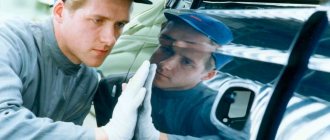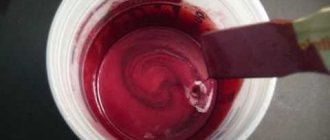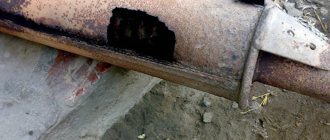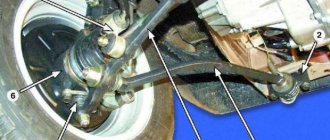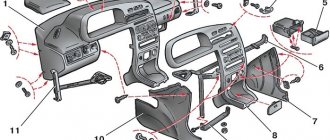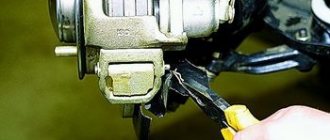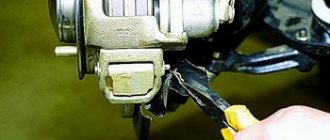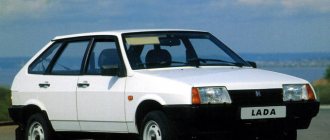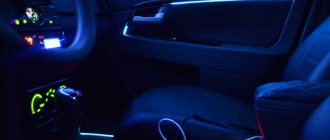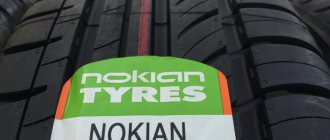Most of the used cars are real rubbish, the problem is in the bodies and their characteristics. Damaged and restored cars are often found - it is not safe to buy these. But how can a beginner recognize a damaged car? You can recognize it, you just need to know what thickness of paint should be on cars.
The fact is that it is very difficult to paint a restored car with a factory paint layer thickness - it is expensive, and not every reseller will paint it perfectly. It is much easier and cheaper to paint it somehow, but beautifully, and hiding all the imperfections. And under the layer of paint there may be a weld that is not factory (often a car is assembled from two or more parts). Under the layer of putty and paint there may be holes and rotten metal.
Knowing how thick the paint on cars usually is, you can recognize a painted car, which means that it was definitely involved in an accident.
How to determine the thickness of paint on a car?
A simple device - a thickness gauge - will help you check your car for paint thickness. This is relatively new equipment that will help you avoid making a mistake when buying a car. It is not at all uncommon for such cases when a beginner chooses a beautifully painted car, and then it turns out that it was restored after a terrible accident literally from scrap metal, the geometry of the body is broken, and there are also other flaws.
A thickness gauge can be purchased at any auto store - the prices for these devices are quite affordable. Let's see how to use this device:
- First of all, the thickness gauge is turned on and applied to the surface being examined - the device will make a certain sound and numbers will appear on the digital screen. This is the thickness of the coating in microns.
- When the paint thickness has been measured, you should compare the result with the factory values. The factory thickness is indicated in special tables - the thickness table is on the Internet, it can be easily found. On average, the paint layer on a car is from 70 to 150 microns - this result is acceptable.
On the working surface of the thickness gauge there is a special sensor that generates waves, and they, in turn, are reflected from the surface of the body. This is how the device picks up signals and converts them into numbers.
When comparing the measurement result with the table, it is worth remembering that the numbers may fluctuate within 10 microns in any area of the body - this is normal. Even at the factory the paint job is not perfect. Paint can have different densities. Anything more is a sign of renovation. On restored surfaces, the paintwork can reach 200 microns or more.
It is also worth remembering that the thickness gauge measures the thickness of the coating with putty and primer. If high values are obtained, repaired areas on the body can be identified.
On video: how to use a thickness gauge.
The gas tank will tell you about repainting
Check the gas filler flap. To paint any element, you need to select a color, which takes time. In order not to keep the car at a service station, painters simply remove the gas tank flap and calmly select the desired paint; this takes a couple of days. On many cars you can immediately see whether the sunroof has been removed. At the attachment points there may be chips, scratches from a screwdriver, for example. There are non-standard bolts or clips - all this may indicate that the hatch has been removed.
If the door handles look older than the body element, it means that after painting or replacing the door, old handles were installed.
The condition of the paintwork must correspond to the mileage. If the car has driven 60,000 km, and the front bumper and the front part of the hood do not have any chips or microdamages, then either the car has driven all these 60,000 kilometers backwards, or the elements have been painted.
By the way, understand that plastic bumpers are consumables, so you shouldn’t get hung up on them, even if they’ve been repainted. It's better to focus your efforts on hardware. The body is important.
Which parts should you check first?
Experts recommend starting from the roof surface - this element is least susceptible to various damages. The roof is tinted very rarely and it is the standard and guideline for all other measurements. The average for the roof will always be lower than for all other parts.
Next, measure the racks - their upper parts can be used as a guide. The front and rear of the body are areas that are very often repaired. You should also pay attention to the front doors and sills. Then measurements are taken in all other external segments.
Don't forget about the internal cavities - the space under the hood, trunk, interior, gas tank hatch.
First of all, measure the parts separately. Suspicious areas are measured 4-5 times - in the center and along the edges. The differences should not be more than 35 microns. Then the arithmetic average is calculated and the total thickness of the paint layer for the entire car is determined.
What is a thickness gauge
A thickness gauge is a device for measuring the thickness of a paint coating. Looks like a small box.
There are many models of thickness gauges on the market, just like smartphones.
Some thickness gauges work at temperatures below zero, others do not. Some models measure aluminum parts, others only work on steel surfaces.
I recommend using professional thickness gauges - these are, for example, models Etari ET111, Etari ET11p, Autotest 112. You can buy one for 5000-7000 rubles.
But if you change your car every three years or less often and don’t plan to use a thickness gauge often, then there’s no point in buying one. You can just rent. It costs from 300 to 500 rubles per day.
Hundreds of thickness gauges are rented out on Avito
Paint thickness table
The table below shows the thickness indicators on different cars. It must be remembered that these are approximate figures obtained empirically. Manufacturers themselves cannot accurately answer how thick the paint is on a car that has just left the factory.
Japanese and Korean cars, for example, Toyota and Kia Rio, are painted so that the thickness is in the range of 100-110 microns. The internal elements are painted more thinly - the thickness gauge will show no more than 40 microns. If the body was polished or subjected to any other nano-treatments, this will not increase the readings too much. But protective films can increase the numbers by 100 or 200 microns.
German cars have a coating thickness from 100 to 165 microns. This also applies to the BMW concern. “X5” models have paintwork thicknesses from 120 to 165 microns. At Daewoo they paint bodies up to 90-120 microns. Lada Granta will have a layer thickness from 110 to 140 microns. Priora or Kalina are usually colored within 60-100 microns. Kia Rio is painted from 120 to 150 microns. Chevrolet Cruze - 80-135 microns.
What values indicate additional layers?
If additional layers were applied to the factory paint, then the device will show from 180 to 260 microns or more. This figure is obtained by adding the value of the paint thickness from the factory and the additional layer - all modern devices can handle this.
If the display shows a value of 300 microns or more, then a layer of putty was also applied to the part. A large number is a signal that repairs were carried out and the body was painted over very carefully.
It is also worth remembering that the coating on internal surfaces is thinner. On the Lada Granta it will be from 40 microns and above. Koreans also save on paint - about the same amount on the Kia Rio.
The most important task in the measurement process is to see the first layer of paintwork outside the factory. At the same time, its thickness may completely coincide with the factory values. So, using the device, they check each element in several places and do not forget about the corners and edges. On factory parts there should not be significant differences in thickness within one element.
What does it mean about outside interference?
So. For example, Lada Granta is for sale. Knowing its approximate factory values, you can begin to take measurements and see how much larger they are than the factory values. Repainting is indicated by differences in local numbers from the average throughout the body by 40% or more, as well as an excess of the average values for the car by 190 microns.
Also, the fact of intervention is indicated by indicators higher than in the tables, by 50-90 microns. If minor defects were repaired, the indicators will exceed the norm by 50-150. Exceeding the norms by 150-250 microns will indicate the repair of significant defects. The thickness of the putty will be 250-300 microns higher than normal.
When choosing a car, you must use instruments - everyone uses them. The check will protect you from buying a damaged or damaged car - and it doesn’t matter whether it’s a Lada Granta or a Bentley Bentayga.
Measuring paint thickness on Suzuki and Skoda Rapid (2 videos)
What can help in determining (20 photos)
Types of thickness gauges
A thickness gauge is a special device that measures the thickness of the paint coating applied to body parts. There are several types of such devices. They differ in the principle of their action. The device can be:
- magnetic;
- ultrasonic;
- electromagnetic;
- eddy current
Magnetic thickness gauges have a rather primitive design. There is a small magnet in the body of the device, the force of attraction of which to the metal elements of the body varies depending on the thickness of the paintwork. The readings are transmitted to the arrow, the angle of deflection of which determines how much paint is applied to the car body in one place or another. The advantages of such devices include low cost, ease of use and the ability to work without batteries. The disadvantages are low accuracy of readings.
Electromagnetic thickness gauges are more expensive, but they are more accurate. The main disadvantage of such devices is that they can only be used to measure the parameters of paintwork on hardware. It is not possible to check the quality of painting of a part made of non-ferrous metal or plastic.
Eddy current instruments have excellent measurement accuracy. They cost more than electromagnetic ones. The main disadvantage is the dependence on the conductive properties of the material. For example, when taking measurements on aluminum or copper parts, they provide very accurate data, but on ordinary metal they work with errors.
Ultrasonic devices are the most accurate and versatile. They can be used when working with metal, plastic, composite and other materials. The only drawback of such devices is their high cost. They are usually used to check vehicle paintwork at branded service stations.
Depending on the operating principle and accuracy of the readings, the price of a thickness gauge can range from 2 to 30 thousand rubles. If you want to measure the thickness of paint on a car, but you don’t have enough money to buy a good car testing device, you can rent such a device. The rental price varies from 500 to 600 rubles. per day.
What the thickness gauge will show
Using a thickness gauge is simple: take a calibrated device and apply it to the car body at a right angle. It will immediately show the coating thickness in micrometers. One micrometer is one thousandth of a millimeter.
I applied the thickness gauge to the body of my car. Coating thickness - 117 microns. Everything is fine, my car was not painted (I already knew this, but for your use as an example)
The higher the value the thickness gauge shows, the larger the paint layer and the higher the likelihood that this car was repaired after an accident. Typically, the factory paint layer on steel parts of a car is no more than 200 microns.
Readings above 200 microns indicate repainting.
Readings of up to 300 microns occur if a cosmetic defect has been painted over on the car, for example a scratch from a key. This does not affect the safety of passengers in any way, but you can still bargain.
Readings closer to 1000 microns indicate that there is still putty under the paint. A body element with such indications was definitely severely deformed in an accident and was puttied during repairs. If the work is done poorly, the paint on the putty may crack and fall off over time.
More than 1000 microns is a sign of serious body repair, which means participation in a serious accident. It is better not to buy a machine with a coating layer of more than 1000 microns.
2000 microns is the maximum value that the thickness gauge can show. If the layer is thicker, the device will not show numbers. This means that there is a lot of putty at this point.
Check in advance what the factory paint thickness should be on the car model you are going to buy. This information can usually be easily googled using a query like “Mazda 3 paintwork thickness.” A small scatter of readings is acceptable, but not more than 60 microns.
There are comparative tables of normal coating thickness for different cars on the Internet.
